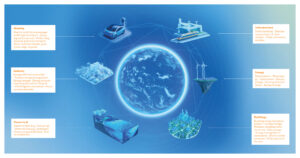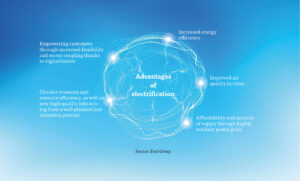One of the most important strategies for reducing energy-related CO2 emissions is electrification. In this All Electric Society, the electricity used should be generated exclusively from renewable energy sources, providing global access to affordable, clean energy supply.
The polar ice caps are melting, and sea levels are rising. Some regions are experiencing an increase in severe weather and heavy rainfall, while others face extreme heatwaves and droughts.
“As the UN system’s authoritative voice on weather, climate, and water, we see every day that our climate is sounding a red alert,” warns Ko Barrett, Deputy Secretary-General of the World Meteorological Organisation.
To stabilise the climate in the long term and limit global warming to 1.5 degrees Celsius, the sixth assessment report of the Intergovernmental Panel on Climate Change (IPCC), published in 2023, states that global greenhouse gas emissions must be reduced by 60 percent by 2035 compared to 2019 levels.
Electrifying energy consumption
One answer to this is the All Electric Society – the idea of a CO2-neutral and sustainable world, where energy is almost exclusively generated and consumed electrically. The goal is “direct” electrification, where electricity is generated CO2-free – particularly in end-use sectors, which are the main cause of global greenhouse gas emissions. Currently, less than 25 percent of the energy consumed in Europe is electricity. The rest, used for heating homes, fueling vehicles, and running factories, mainly comes from fossil fuels. To achieve climate neutrality by 2050, up to three-quarters of Europe’s final energy consumption must be directly or indirectly electrified.
The basis: renewable energies
This electricity must, of course, come from sustainable sources, as Fatih Birol, Executive Director of the International Energy Agency (IEA), emphasises:
“The power sector currently causes more CO2 emissions than any other sector of the global economy.”
However, renewable energies already accounted for a record 30 percent of global electricity generation in 2023, driven by the growth of solar and wind energy. Although global energy-related CO2 emissions continued to rise in 2023, the increase was smaller than in 2022 thanks to the expansion of technologies such as solar, wind, and electric vehicles, as IEA analyses show.
Storage via hydrogen and eFuels
The All Electric Society focuses not only on electricity generation but also includes sectors like heating, mobility, and industry. In areas where electrification is not possible or too expensive, such as in heavy industry, shipping, and aviation, the concept of the All Electric Society envisions “indirect” electrification: renewable electricity is converted into green hydrogen and eFuels through electrolysis. To reduce primary energy demand, energy efficiency for consumers should also be increased as part of the electrification of as many sectors as possible.
Linking sectors together
An important element of the All Electric Society is the linkage of various sectors such as transport, industry, commerce, and housing. Energy generation, distribution, storage, and consumption are considered as a holistic system. The different areas exchange energy among themselves, ensuring it is sufficiently available everywhere – at the right time, in the right place, at low cost. This requires that the sectors are interconnected digitally. Standardised communication protocols within various networks enable the necessary communication, free from system boundaries.
“Deep digitalisation, including the application of AI, is crucial for managing the increased complexity of a renewable-dominated power system,”
explains Remi Eriksen, Group President and CEO at DNV, which provides certification and technical advisory services for the energy value chain.
Key to sustainability
Solutions and technologies for electrification, networking, and automation are thus the key to the sustainable All Electric Society. “Electrification will play a crucial role in the next decades to deliver an efficient, secure, decarbonised and integrated energy system. Electricity will become our main energy carrier by 2040, and we need to ensure that both the market conditions and infrastructure will push the transition forward.”





